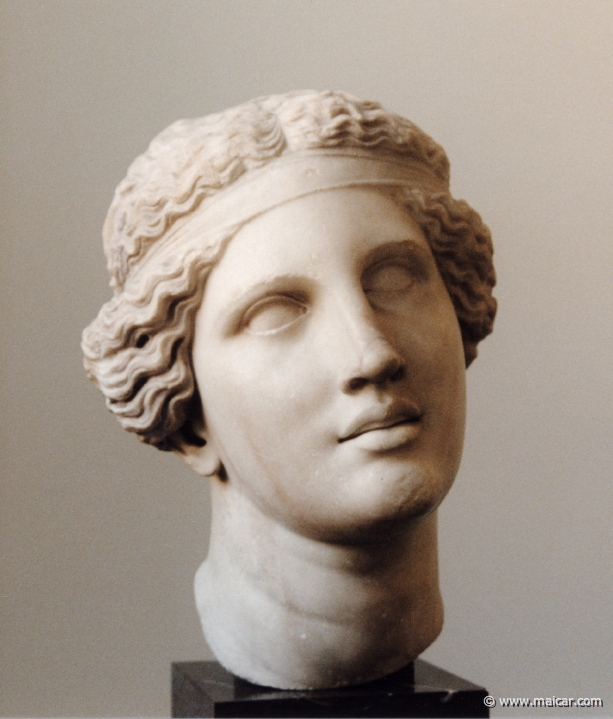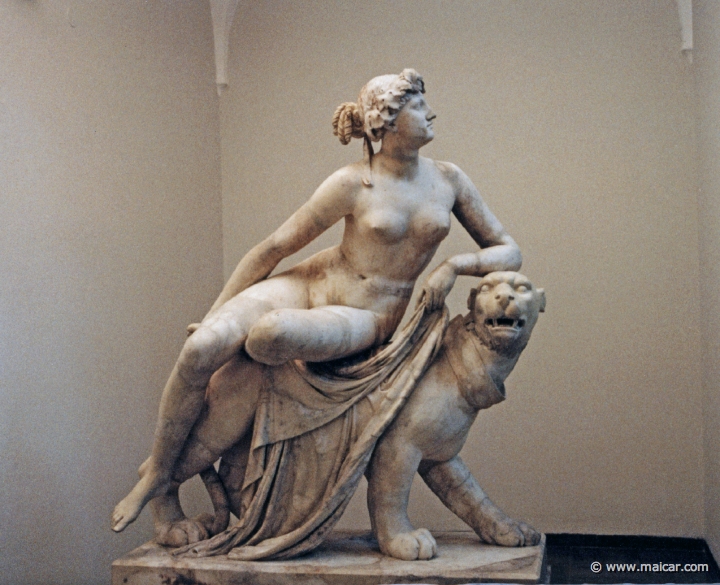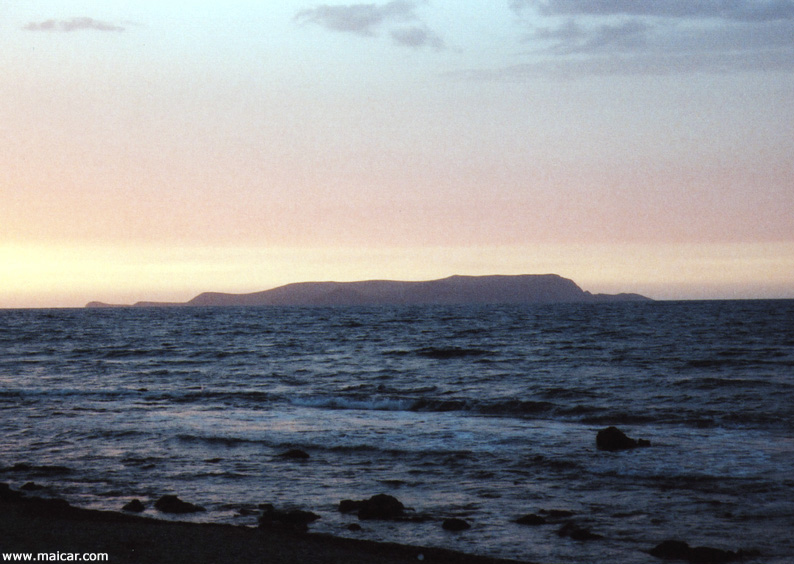|

|
Ariadne. 2133: Roman copy of a Greek statue from the end of the 4C AD. Pergamon Museum, Berlin.
|
|
When Theseus came to Crete, Ariadne, having fallen in love with him, offered to help him to disclose the way out of the Labyrinth if he would agree to take her to Athens and made her his wife. Theseus agreed and swore to do so, but after leaving Crete he deserted her in Naxos. There she was found by the god Dionysus 2, who fell in love with her.
Early life unknown
Ariadne was one of the many children of King Minos 2 of Crete. During her time, the naval power of her father decayed, and she contributed to it by providing aid to Theseus, prince of Athens. And it is when Theseus came to Crete that Ariadne came into the story, for we know nothing about her childhood.
The tribute
The story says that Ariadne, having consulted the architect Daedalus (the same that constructed a dancing floor for her at Cnossus), helped Theseus to find his way out from the Labyrinth, where he was supposed to be destroyed by the Minotaur, as had been all young men and women that until then had been yearly sent, as a tribute, from Athens to Crete. Theseus was among those who were sent from Athens as the third tribute to the Minotaur, and some have said that he offered himself voluntarily to be a part of this group. In any case, when Theseus arrived, Ariadne fell in love with him and offered him help if he would agree to marry her and take her with him to Athens.
Ariadne's thread
Theseus, whose life was in danger, agreed on oath to do so, and Ariadne obtained from Daedalus, the constructor of the Labyrinth, the necessary instructions for finding the way out. At Daedalus' suggestion, she gave Theseus a ball of thread, which he fastened to the door when he went in, so that, after killing the Minotaur, he could make his way out by gathering the thread.
Naval battle
This is how Theseus saved his own life and the lives of the young men and girls that had been offered to the Minotaur. When he came out of the Labyrinth, he sailed with them and Ariadne from Crete and came to the island of Naxos, which is one of the Cyclades, and in order to prevent the Cretan fleet to pursue them, he staved in the bottoms of the ships. But some have said that there was a naval battle in the Cretan harbor as Theseus was sailing out, in which a general of Minos 2, Taurus 1, lost his life. It is also told that General Taurus 1 was conquered by Theseus in wrestling during certain funeral games held by King Minos 2. The Cretans, including the king, were particularly pleased to see their own general defeated in the games. Apparently, he was a hateful personage, being accused besides of having intimacy with Queen Pasiphae. It is told that Ariadne saw Theseus for the first time during these games.
Invasion of Crete
Still others affirm that Theseus came to Crete with a fleet in order to punish Deucalion 2, who had succeeded his father Minos 2 on the throne of Crete, after the king died in Sicily looking for the fugitive Daedalus. As they say, Daedalus came to Athens, and when this was known, Deucalion 2 demanded Daedalus delivered to him, or else he would kill the Athenian hostages. Theseus answered with courtesy, but he secretly built a fleet, receiving help from King Pittheus of Troezen. When it was ready he set sail, taking with him Daedalus and some Cretan exiles as guides. While doing all this, Theseus kept the friendly atmosphere, so that when the Cretans saw the fleet approaching they did not suspect it to be hostile, and that is why Theseus easily made himself master of the harbor. Having disembarked his troops, he came to Cnossus and took it by surprise, killing Deucalion 2 and his body guard at the gate of the Labyrinth.
|

|
Theseus, about to enter the Labyrinth, holds Ariadne's thread in his hand. 4503: France, debut de XIXe siècle: Ariane et Thésée. Musée des beaux arts, Rouen.
|
|
Treason not rewarded
According to the tale of the thread and also in accordance with Theseus' oath, Ariadne and Theseus should have sailed to Athens. But that never happened, probably because Theseus could not suffer to marry her who had betrayed her country. Such deeds are rarely rewarded: When Scylla 2, for the sake of her passion for the besieger Minos 2, betrayed both father and city, he, on becoming the master of Megara, tied her by the feet to the stern of a ship and drowned her. And Amphitryon killed Comaetho 1, who having fallen in love with him, betrayed his father and the kingdom of Taphos to him. Also Pisidice 4, princess of Methymna in the island of Lesbos, fell in love with Achilles when he was besieging the city, and she promised to put the town into his possession if he would take her to wife. Achilles consented, but when the town was in his power he bade his soldiers stone her.
What happened afterwards
What in fact took place when Ariadne and Theseus left Crete, if they did leave together, has been narrated differently: Some have said that Ariadne hung herself when she saw herself abandoned by Theseus. Others say that she was conveyed to Naxos by sailors and that there she lived with Oenarus, priest of Dionysus 2. It has also been told that Theseus and the pregnant Ariadne separated in Cyprus, where they came driven by a storm. Theseus set her on shore alone, but while trying to save the ship, he was borne out to sea by the waves. Ariadne then was taken into the care of Cyprian women, who in order to comfort her in her loneliness, brought her forged letters which they said had been written by Theseus. They also buried her in a grove when Ariadne died before giving birth. Still others say that Theseus feared the reproach of the Athenians if he brought Ariadne to the city and so, having come to Dia (an island north of Crete, opposite Cnossos), he left her while she was asleep. And some say that here she was killed by Artemis, following instructions of Dionysus 2, but others say that Dionysus 2 married brown-haired Ariadne, and Zeus made her deathless and unageing for him.
The Crown of Ariadne
|

|
Ariadne and Dionysus 2's panther. 1030: Ariadne. Statue by Johann Heinrich Dannecker, 1758-1841. Städtische Galerie-Liebighaus, Museum alter Plastik, Frankfurt.
|
|
Dionysus 2 then put the Crown (Corona Borealis) among the constellations, for when he married her on the island of Dia they received wedding gifts from the gods, and among them there was a crown, gift of Aphrodite and the HORAE. Yet others have said that Dionysus 2 received this golden crown with Indian gems from Ariadne herself as a present. A valuable one, for by the glow of the gold and gems Theseus had been able to make his way out of the gloomy Labyrinth, and not as others believed by unwinding the so called Ariadne's thread. But others have said that the crown was given to Ariadne by Theseus after having taken it from the depth of the sea. For when Theseus came to Crete with the youths there was a dispute between him and King Minos 2 who, refusing to believe that Theseus was Poseidon's son, drew a gold ring from his finger and cast it into the sea, where it could be easily found by a son of Poseidon. So Theseus cast himself into the sea and brought back, not only the ring of Minos 2 but also the crown that the Nereid Thetis had received from Aphrodite as a wedding gift (though some believe this crown came from Amphitrite, wife of Poseidon). And as Theseus had now proved both lineage and courage he received Ariadne as wife and he gave the crown to her.
Ariadne on his mind
On returning from Crete, Theseus was supposed to spread white sails on his ship on approaching Athens. But he, worried because of the loss of Ariadne, forgot the signal that he had agreed with his father Aegeus 1 who, seeing from the Acropolis in Athens the ship with a black sail, thought that Theseus had died, and cast himself down and perished. Homer tells in the Odyssey 11.325 that Artemis killed Ariadne on the island of Dia at the instigation od Dionysus 2, when the Cretan princess arrived there with Theseus. Apollonius Rhodius, Argonautica 4.433, says that Theseus forsook her in the island (where they had come escaping from Cnossos), and as we know he sailed to Athens without her. So also Hyginus, Fabulae 43, who says that Theseus and Ariadne were detained by a storm in the island of Dia, where Theseus had second thoughts about his bride (he feared shame and the reproaches of the Athenians), and left her while she was asleep. Thus through the heavenly marriage of Dionysus 2 and Ariadne, Theseus lost his bride and later married her sister Phaedra.
|

|
9632: The island of Dia (seen from the Cretan shore at Analipsi) where Theseus forsook Ariadne. Dia is off the northern coast of Crete, opposite Heracleium, the seaport of Cnossos.
|
|